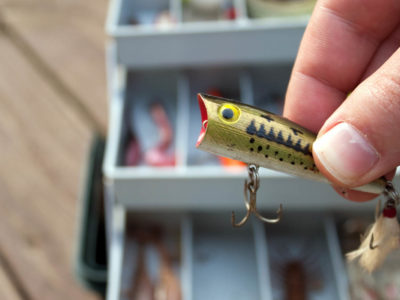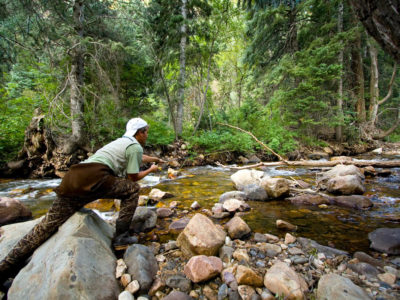Before you know it spring will be here, and bass will be emerging from their winter depths eager to stock up on food and eventually get to spawning. What are the best spring bass lure colors to entice those dopey fish onto the end of your line?
Here is a brief rundown on the best lure colors to use, which colors to avoid, and how to mix and match so that you choose the right lure color every time.
Table of Contents
How to Choose the Right Lure Color in Spring
If you follow this formula you will match your colors to your fishing environment and have a better chance at convincing a lunker to go after what you are offering.
- Match water clarity to sunlight and known bass food for that vicinity
- Avoid throwing something completely unfamiliar or something that will not get noticed
Follow this chart to select the best spring bass lure colors (these are not listed by priority):
| Sun Exposure | Water Clarity | Bass Lure Colors |
|---|---|---|
| Sunny | Clear | Shiny metals or contrasting natural colors (like silver on black) that are visible but not obnoxious |
| Sunny | Murky | Add flash and present white, yellow or chartreuse or anything that attracts attention |
| Cloudy | Clear | Stick to all-natural colors and use flecked baits that are red, green, black or brown |
| Cloudy | Murky | White, chartreuse, orange, black and blue will give best results |
Remember though, no rules on color, flash, or presentation are hard and fast. You need to be willing to experiment a little to dial in what the bass around you will target. For example if the water is choppy, running a white or pearl fluke near the top can convince a bass to strike no matter the water clarity or visible sunlight.
You need to experiment!
The Best Spring Bass Lure Colors
When selecting colors for you spring bass lures you are looking to choose a color that will keep the bass interested without scaring them off. Remember, they’ve only just emerged from a long dormant period of cool winter waters and are now testing out what the early spring waters have on offer.
In my experience the specific choice of color is not as important as getting your general color scheme correct, and I will often switch between colors within the same scheme when fishing during the spring.
There are three conditions to pay attention to when picking out the best spring bass lure colors for that day:
- Water clarity
- Sunlight exposure
- What bass are eating right now
Water Clarity
Bass will not usually go after something that looks unfamiliar to them, at least until the summer warmth juices their metabolism and makes eating just as important as what is on the menu. That means your presentation must look like food the bass has at least seen before or be something that attracts the bass’ attention but in a good way.
In clear water, natural colors are the way to go. Bass have incredibly good eyesight, which means you usually cannot fool them into going after something that looks out of place or unnatural. Natural colors like pumpkin, olive, brown, black work well.
In murky water, attracting the bass’ attention becomes the focus. Colors that attract in muddy water are not usually natural. The colors need to stand out beyond the darkness. They include bright white (pearl), chartreuse, pink, or orange. The exception to this is that, for some reason, I have found black and blue presentations also work well in muddy water. In you are having trouble getting a bite on a spring morning try switching out to one of these dark colors and see how you go.
Complicating all this is the vision of your average bass. Bass see things through a yellowish prism, which makes trying to match color distinctions based on what a human sees a bit tricky. For example, they usually cannot discern between off-white and pearl or between blue and black. They can, however, see reds and greens very clearly.
Sunlight Exposure
If you have ever seen minnows in the shallows glinting off the sunlight you understand this concept. Sunlight glinting on silver fools bass into thinking a lure is baitfish. Use silvery or gold spinners and contrast between black and white or silver when the sun is shining on an early spring morning.
Even on cloudy days, a silver lure can pick up enough light to create a flash. To create that needed attention, add an orange bead or spinner above your weight. The movement, the flash, and the bead might get the attention you need to prompt a strike.
What Bass Are Eating Right Now
Bass are not picky eaters. That is why you can find oddities in a bass’ stomach, like metal washers, pieces of wood, stones, etc. That said they will not usually swallow something they are not familiar with.
Before selecting a lure or lure color, take a moment and observe where you are fishing. What is swimming about? Is there any indication of what bass are going after?
PRO TIP: Figure out what the bass are chasing then pick your lure and lure color to match. You will increase your chances of success greatly!
As with any type of bait though you must present it in a way that either looks natural or prompts a reaction strike. Try out different presentation methods with different colors. Note what attracts interest, what goes untouched, and what drives bass to strike. Then, narrow your lure and color choices until you have a match for both.
This is where local knowledge comes into play. Nothing beats a couple of seasons of testing out what the best spring bass lure colors are for your local fish population.
Spring Bass Colors to Avoid
The best way to think about what to avoid is to take the advice above and reverse it. Avoid presenting pinkish baits in crystal clear water. Add flash to your bait in murky water so it does not become lost in the murk. Do not get hung up on exact color matches so much as general color schemes. If you find yourself agonizing over whether to use a green or a chartreuse lure you are stuck way down in the weeds. Make a choice and throw your line.
Most importantly (here is this point again) do not throw something the bass have never seen at them, at least not until summer when their metabolism is demanding they eat anything that fits in their mouths. You can have the best color scheme imaginable, but if your bait looks foreign or menacing bass will be indifferent and not even take a nibble.
The Last Cast
The key to spring fishing is to put something in the proximity of a bass that looks and acts like something the bass might want to eat. Color plays a role in that, as does the weather and the water color. The advice above will help you mix and match your baits to give yourself the best chance at convincing a bass to bite.
Remember though, some fine-tuning is always necessary to dial in what the bass in your neck of the woods are responding to and as importantly, what they are ignoring.
What spring bass lure colors work best in your part of the world?
Editor’s Picks



